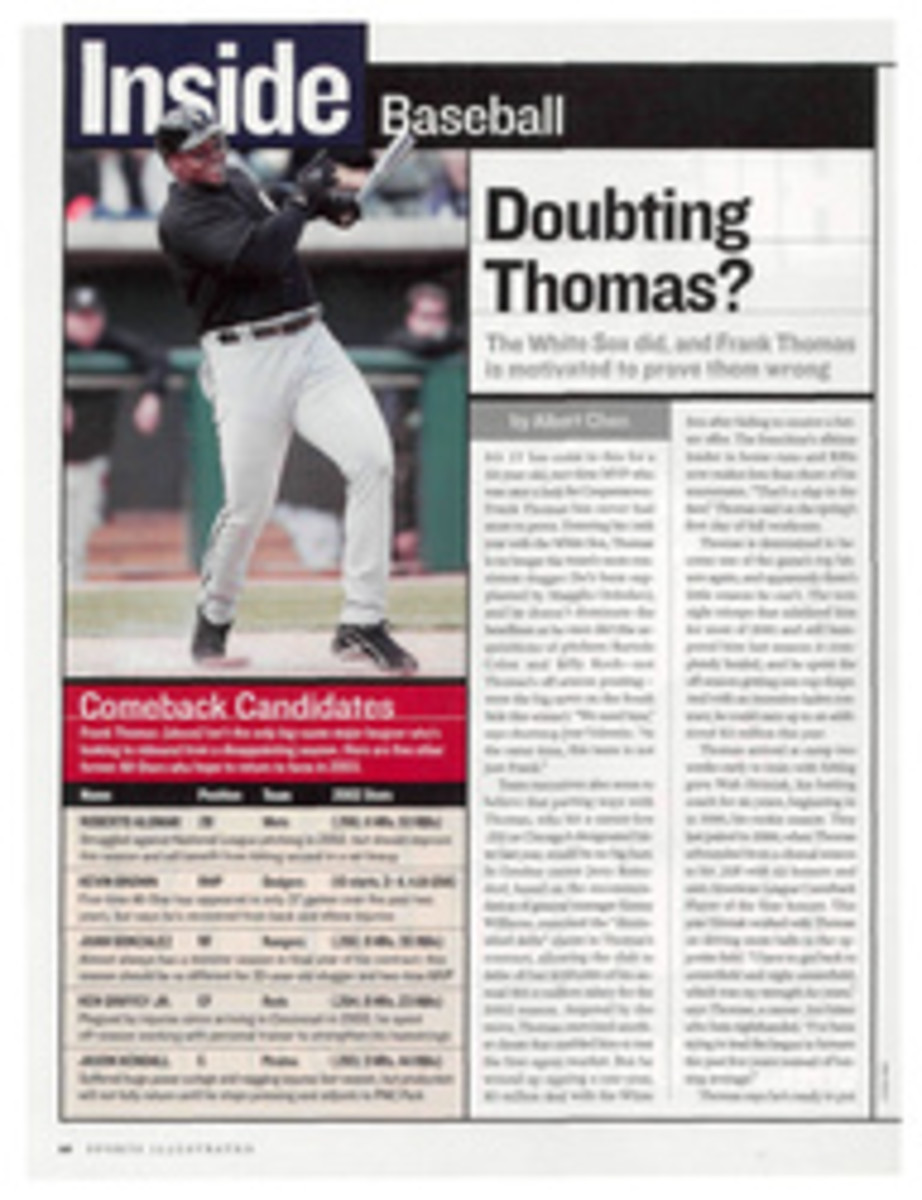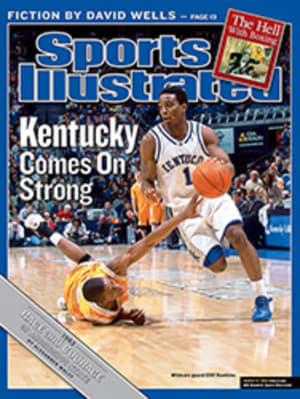
Old Reliable Still going strong after a record 1,187 appearances, Padres lefty reliever Jesse Orosco, 45, now makes his living one batter at a time
"The Indians landed reliever Jesse Orosco, who's widely perceived
to be over-the-hill." --SPORTS ILLUSTRATED, Dec. 19, 1988
Jesse Orosco has just run over a cat. We don't know the feline's
name or where it lived, but it was light brown with a white
tail. Please, do not call PETA. The mishap has occurred at
night on winding and poorly lit Stone Canyon Road in Poway,
Calif. Orosco was cruising in his black Humvee, well below the
35mph speed limit, when Bootsie or Frisky or whatever dashed
from under a bush and--ba-dump--into the path of the left front
tire of Orosco's vehicle and.... "Oh, no!" cries Orosco.
"Oooooh nooooooo!" He gently taps the brake, a look of despair
on his face. The man has spent 23 seasons in a test of nerves,
pitching to the biggest, baddest hitters baseball has had to
offer. He has saved 142 games and won 85 more, and twice he has
been a member of a world champion. Yet he is suddenly rattled.
"Man," he says, "I've never, ever, ever killed a cat before."
With this, Orosco, his face now the color of snow, continues on
up the hill. Several times, he sighs deeply. "I just can't...."
he says, failing to finish the thought.
A lefthanded reliever who turns 46 on April 21, Orosco knows as
well as any ballplayer how quickly life in the majors can be
snatched away. And, much like the cat, Orosco, the alltime leader
in games pitched (1,187), is heading into the ninth--and
presumably the last--of his baseball lives. He began his career
in 1978 as a minor leaguer in the Minnesota Twins organization
(1) and then played in the majors with the Mets (2), Los Angeles
Dodgers (3), Cleveland Indians (4), Milwaukee Brewers (5),
Baltimore Orioles (6), St. Louis Cardinals (7), and the Dodgers
again (8) before signing on Nov. 20 with the San Diego Padres (9).
With the retirement of 43-year-old outfielder Tim Raines and with
outfielder Rickey Henderson, 44, and righthander Mike Morgan, 43,
still unsigned, Orosco is the only active major leaguer to have
played in the 1970s, '80s, '90s and 2000s. When general manager
Kevin Towers signed Orosco to a one-year, $800,000 contract to be
the Padres' lefthanded relief specialist, he not only acquired a
player nearly five years his senior but also reunited old
batterymates--Orosco and manager Bruce Bochy, who caught the
lefty with Triple A Tidewater in 1979 and '81. "Some guys play
themselves out of the league with bad attitudes, and some guys
lose their edge or skills," says Davey Johnson, Orosco's manager
with the Mets and the Orioles. "Jesse has that unique, God-gifted
ability to play for a looooong time."
Why so? Johnson pauses knowingly. "Well," he says, "have you seen
his left arm?"
While Orosco's body is sort of pear-shaped, despite five
weightlifting sessions a week, that left arm is a beauty; tan
from the California sun, with short, light hairs, a couple of
freckles here and there, and nary a tattoo. Orosco would be wise
to consider arm modeling as a postbaseball profession. In
throwing 1,126 1/3 innings Orosco has had only one arm injury: a
torn flexor muscle in April 2000 that caused him to miss most
of the season. "He has an arm made out of rubber," says Dodgers
closer Eric Gagne. "It's a rare gift, and he's got it." From
1982 through '99 Orosco averaged 62.5 appearances per season,
but his longevity can be attributed in part to the fact that he
has averaged less than one inning per outing every season since
'91.
If there has ever been an ideal period in baseball for a
prehistoric lefthanded relief pitcher, it's now, when complete
games are at an alltime low and specialization is the bullpen
buzzword. But upon hearing that San Diego had signed Orosco, some
rival G.M.'s greeted the move with skepticism. Why would a young,
rebuilding team sign an ancient pitcher? Answer: The Padres play
in the NL West, which is loaded with five of the game's most
dangerous lefthanded power hitters: the San Francisco Giants'
Barry Bonds, the Dodgers' Shawn Green, the Colorado Rockies' Todd
Helton and Larry Walker, and the Arizona Diamondbacks' Luis
Gonzalez. "Baseball's changed a lot from back when Jesse was
coming up," says Towers. "Nowadays, we all want--need--that one
guy who can get a dangerous lefthanded hitter out late in the
game. I don't care if he's 46 years old. That's what Jesse does."
Last year for Los Angeles, Orosco led the majors with 26
one-batter appearances--22 of them against lefthanded
hitters--and got the out 20 times; overall, lefthanders batted
.238 against him. Bonds is 4 for 25 lifetime facing Orosco, Green
is 2 for 11 and the Philadelphia Phillies' Jim Thome is 0 for 13.
The Orosco fastball that once traveled 91 to 93 mph now hovers
between 86 and 88. But like most survivors, he has learned to
adjust. When his velocity dropped off, he depended more on his
slider, and when his slider began to flatten, he picked up a
split-finger changeup that has become his out pitch.
Early in his career Orosco thrived as the Mets' closer, twice
earning All-Star Game invitations. When he was traded to L.A. in
1988, manager Tommy Lasorda turned him into a setup man. By the
time Orosco reached Baltimore in '95, he was almost exclusively a
one-batter lefty. "The reason I'm still around is because I feel
the same way I did when I was in Little League, greasing up the
mitt before the season," he says. "I'm excited for spring
training. I love batting practice. The games are thrilling, even
if I'm sitting in the bullpen. I'm the little boy who loves
baseball. I don't care what my job is."
Several years ago, when it became clear that he could pitch
beyond the normal span of a major league career, Orosco and his
agent, Alan Meersand, worked out a plan. Instead of demanding
outrageous wads of money and scaring teams off, Meersand and
Orosco asked for more modest salaries. "The most Jesse has ever
made in a season is around $1.6 million, and that was in the
'80s," says Meersand. "We never wanted to price him out of the
game, where teams would shy away. Jesse's always just wanted a
place to play and a comfortable life for his family."
Orosco says he will play one or two more seasons ("I want to
retire with dignity," he says), but his brown eyes twinkle with
intrigue when the possibility of pitching at age 50 is suggested.
There are those among his inner circle who believe that Orosco
could--in fact, should--join 58-year-old Satchel Paige of the
1965 Kansas City A's and 50-year-old Jack Quinn of the '33
Cincinnati Reds as the only pitchers whose careers survived
beyond their 50th birthdays. "His arm will never die," says
Gagne. "I mean it. Never."
Leticia Orosco, who married Jesse 18 years ago and has spent most
of her summer nights without him, says, "If Jesse quits before
his heart tells him to, I'd be very sad. How many of us live our
dream?" She and the couple's three children--Jesse Jr., 15;
Natalie, 10; and Alyssa, 8--live year-round in Poway, so they are
glad that his new team's ballpark, Qualcomm Stadium, is only a
15-minute drive from home.
As he stands for the national anthem before every game, Orosco
thinks about the man he grew up idolizing--his father, Raymond,
who died 21 years ago. In the early 1960s, when Jesse was first
learning to love baseball, his father was the owner-manager-ace
of the Santa Barbara Jets, one of the top semipro teams in
Southern California. During the week Raymond was a construction
foreman; on weekends he was the Don Drysdale of the sandlot.
Jesse liked nothing more than serving as the Jets' batboy, toting
Raymond's equipment and mimicking his dad's moves on the mound.
In the summer after his freshman year at Santa Barbara City
College, Jesse worked for his dad in construction. The days were
long and arduous, and one night the son told the father that he'd
rather do anything than spend his afternoons aligning bricks.
Raymond, who years earlier had turned down a minor league
contract from the Dodgers to stay home with his wife and family,
told Jesse, "You have a chance to make it in baseball, but it's
going to take more work than you've ever imagined. A lot of
people play this game, and a lot fail. If you really want it,
then you have to outwork everyone. Are you willing to do that?"
The answer was yes.
After Orosco went 10-2 in his final season at Santa Barbara, the
Twins selected him in the second round of the 1978 draft. A year
later the Mets were peddling veteran lefthander Jerry Koosman and
asked for the young Orosco in return. Minnesota owner Calvin
Griffith's initial response was, "Who?" In eight seasons with New
York, Orosco developed into something of a cult hero. Although
his name might not roll off the tongue like Strawberry, Gooden or
Hernandez, Orosco was on the hill when the '86 Mets won the
dramatic National League Championship Series over the Houston
Astros and the even more dramatic World Series against the Boston
Red Sox. To the denizens of Shea Stadium, Bill Buckner's error
does not symbolize New York's triumph nearly as much as the image
of Orosco, throwing his glove in the air and then falling to his
knees on the mound, arms raised triumphantly, celebrating the
final out of the Fall Classic. "This is how senile fans think I
am," says Orosco. "A couple have said to me, 'Do you remember
when you got the final out of the 1986 World Series?'" He smirks.
"Uh, no. I forgot. Was that me?"
Near the end of his stint in New York, Orosco was replaced as the
closer by righthander Roger McDowell and lefthander Randy Myers,
two youngsters with electric arms and brighter futures. Both
relievers are long retired, as are most of the other pitchers
(Alejandro Pena, anyone?) who were signed as Orosco was phased
out at each stop. Many wanted to learn the secret to his
longevity, only to be frustrated in that quest. Yes, Orosco runs
and lifts weights, but no more and no less than the average big
leaguer. Yes, Orosco eats healthy meals, but he's been known to
scarf down three slices and a couple of Budweisers.
Orosco holds up his blessed left arm. "I've worked hard my entire
life to be a pitcher," he says, "but without this, I'm probably
doing construction."
Nine lives? Why not 10?
COLOR PHOTO: PHOTOGRAPH BY V.J. LOVERO
COLOR PHOTO: CHUCK SOLOMON FOR THE LOVE OF THE GAME "I feel the same way I did when I was in Little League," says Orosco, who celebrated a title in '86.
COLOR PHOTO: JOHN IACONO DOWNSHIFT Orosco's fastball has lost velocity since his Mets days, but he has a new out pitch, a split-finger changeup.
COLOR PHOTO: V.J. LOVERO [See caption above]
COLOR PHOTO: V. J. LOVERO HOME TEAM Signing with the Padres brought Orosco closer to his family (from left, Natalie, Leticia, Alyssa and Jesse Jr.).
Orosco's eyes twinkle when the possibility of pitching at age 50
is suggested. "HIS ARM WILL NEVER DIE," says Gagne. "I mean it.
Never."

